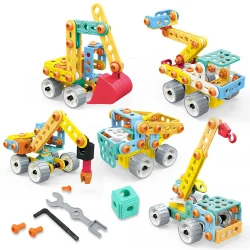Here are some ideas for making your own educational toys at home
2024-05-08
DIY educational toys are fantastic for fostering creativity, problem-solving skills, and learning in children. Here are some ideas for making your own educational toys at home:
1. Sensory Bottles: Create sensory bottles using a variety of materials such as water, oil, glitter, beads, and small toys. These bottles can be shaken and manipulated to stimulate sensory exploration and calmness in children.
2. Shape Sorters: Make a shape sorter by cutting holes of different shapes in a cardboard box or container. Children can then sort various objects or cutouts into the corresponding holes, helping them learn about shapes and spatial relationships.
3. Counting and Math Games: Use everyday objects like buttons, coins, or beads to create counting and math games. For example, you can make a counting jar where children drop objects in and count them as they go. You can also create simple addition or subtraction games using these objects.
4. Alphabet and Word Puzzles: Cut out letters from foam or cardboard to create alphabet puzzles. Children can match uppercase and lowercase letters or spell out simple words. You can also make word puzzles by writing words on pieces of paper and cutting them into individual letters.
5. Science Experiments: Conduct simple science experiments using household items to teach children about basic scientific concepts. For example, you can create a volcano using baking soda and vinegar to demonstrate chemical reactions, or make a homemade thermometer using a plastic bottle, straw, and water to teach about temperature and expansion.
6. DIY Musical Instruments: Encourage creativity and exploration by making homemade musical instruments. You can create shakers using rice or beans in plastic bottles, drums using empty containers and balloons, or guitars using rubber bands stretched over a cardboard box.
7. Building Blocks: Collect various materials like wooden blocks, cardboard boxes, or plastic containers to create building blocks for children to construct with. Encourage them to use their imagination and problem-solving skills to build structures and designs.
8. Nature Exploration Kits: Put together nature exploration kits containing magnifying glasses, containers for collecting specimens, and field guides to encourage children to explore the outdoors and learn about nature.
9. DIY Board Games: Create your own board games using cardboard, markers, and other craft supplies. Children can help design the game board, rules, and pieces, which can be themed around topics they are interested in learning about.
10. Puzzle Games: Make homemade puzzles by cutting pictures or drawings into pieces. Children can then put the puzzle together, developing their problem-solving and spatial reasoning skills.
Remember to involve children in the creation process as much as possible, as this not only makes the toys more meaningful but also encourages them to take ownership of their learning. Additionally, always ensure that DIY toys are safe and age-appropriate for the children who will be using them.



